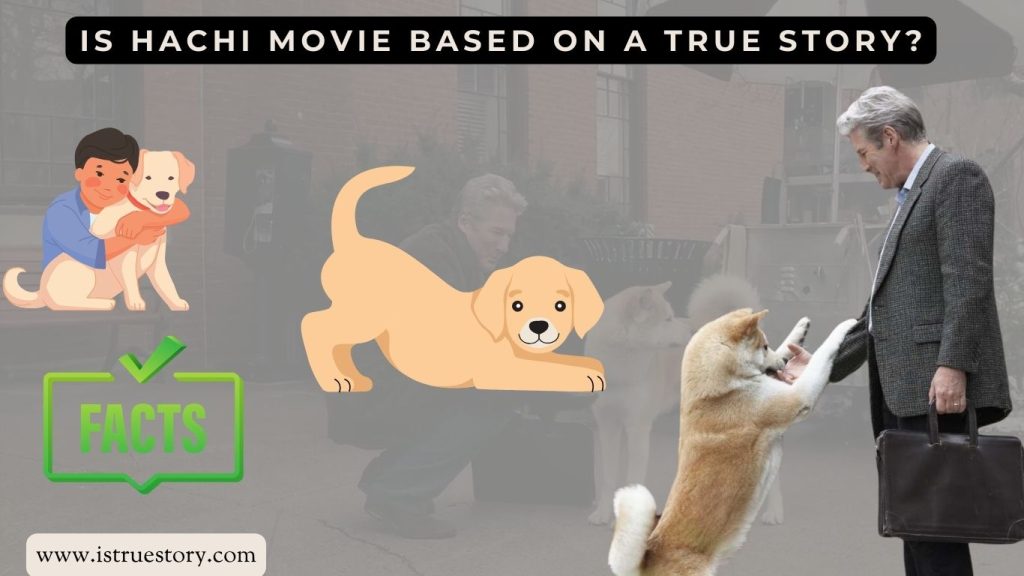
If you’ve ever watched Hachi, you know the film is more than just a dog movie. It’s a story of fierce loyalty, undying love, and a bond that time could never break. But here’s the big question everyone asks:
Is Hachi movie based on a true story?
Yes it absolutely is. And not just loosely inspired by real events. Hachi’s story is grounded in real-life history, emotion, and a dog’s pure-hearted devotion that shook an entire nation.
Let’s walk through this touching journey together, unraveling what really happened, who took care of Hachiko after tragedy struck, and just how this tale of a dog waiting for his owner became one of the most beloved stories in the world.
The Real Hachiko: What Is the True Story Behind the Movie Hachi?
The movie Hachi: A Dog’s Tale (2009), starring Richard Gere, is a Western adaptation of the true story of a dog named Hachikō who lived in Japan in the 1920s. The real story began with a kind-hearted professor named Hidesaburō Ueno, who taught agriculture at the University of Tokyo.
One day in 1924, Professor Ueno brought home a purebred Akita dog from Japan’s Akita prefecture. He named the dog Hachikō (often shortened to Hachi), which means “eight” a symbol of good fortune in Japanese culture.
Every day, Hachikō would walk with the professor to Shibuya Station in Tokyo and wait for him to return from work in the evening. Rain or shine, the dog was always there.
But one day, everything changed.
In May 1925, less than a year after they met, Professor Ueno died suddenly from a brain hemorrhage while at work. He never returned to the station. But Hachikō? He kept waiting.
For nearly 10 years, Hachikō came back to the train station every single day at the same time, patiently waiting for his master’s return. Passersby and station workers began to notice this loyal pup, and his story started to spread across Japan. Newspapers picked it up. People came just to see him.
And so, a legend was born.
Who Took Care of Hachiko After His Owner Died?
After Professor Ueno’s unexpected death, Hachikō didn’t just disappear into the shadows. While he kept his daily vigil at the station, he still needed food and shelter.
Initially, Hachikō was taken in by various families, including Ueno’s former gardener Kobayashi, who lived near the station. While Hachikō technically had a home, he still made the long trip to Shibuya Station every day, driven by the hope that his owner might come back.
Over the years, station workers and commuters grew deeply fond of Hachikō. Many gave him food, built him a little shelter, and looked after him like he was everyone’s dog. He became a symbol of loyalty and devotion something deeply valued in Japanese culture.
Even the Japanese government took notice. In 1934, while Hachikō was still alive, a bronze statue was erected in his honor right outside Shibuya Station. And believe it or not, Hachikō attended the unveiling himself.
Can you imagine? A dog being honored while still alive, surrounded by a city that had come to love him as its own.
Is Hachi the Dog Still Alive?
No, Hachikō is no longer alive but his legacy never died.
Hachikō passed away on March 8, 1935, right near Shibuya Station. He was around 11 years old. His body was found on a street, peacefully lying in the very area where he had waited for so many years.
An autopsy later revealed that he likely died from cancer and heartworm. But to many, it didn’t matter how he passed. What mattered was how he lived with undying devotion and loyalty that touched the hearts of millions.
Today, Hachikō’s body is preserved at the National Museum of Nature and Science in Tokyo, lovingly displayed for visitors who want to pay their respects. It’s not creepy it’s a way to remember him, to stand before history, and feel something deep inside.
And that statue outside Shibuya Station? It still stands tall. People from all over the world come to take photos, leave flowers, or just stand quietly in awe of a dog who showed the world what loyalty really means.
How Many Dogs Were Used to Film Hachi?
In the 2009 film Hachi: A Dog’s Tale, the role of Hachi was actually played by three different Akita dogs:
Chico – played Hachi as an adult in many of the movie’s key emotional scenes.
Layla – used for lighter scenes and calmer moments.
Forrest – filled in as needed for certain sequences.
The filmmakers also used puppies to portray Hachi during his early days. Each dog had a slightly different personality, but together they created a seamless portrayal of one unforgettable character.
Training Akitas isn’t easy they’re strong-willed, proud, and sometimes stubborn. But the production team worked with expert trainers to ensure the dogs were happy, safe, and able to deliver powerful emotional performances.
Even though they were acting, it felt real. Every tail wag, every longing stare, every time Hachi sat and waited it broke our hearts and mended them all at once.
Why the Movie Hachi Still Hits Us So Hard
Let’s be honest. Dog movies often make us cry. But Hachi hits differently. Why?
Because it’s real.
You’re not crying because a screenwriter imagined a tearjerker ending. You’re crying because a real dog once waited for a man who never came back for ten whole years. You’re moved because that kind of love feels impossible in today’s world.
And yet, it happened.
The film doesn’t dramatize much. In fact, it stays surprisingly true to the original events. It just adds a Western twist setting it in a small American town, casting a famous actor, and giving it a soft cinematic polish.
But at its core, the story remains untouched.
“Hachi is not just a dog,” one viewer wrote. “He’s a reminder of what it means to be loyal, no matter what.”
The Cultural Legacy of Hachikō
In Japan, Hachikō is more than a story. He’s a national treasure. His tale is taught in schools, depicted in books, and honored in art. The statue at Shibuya Station is a favorite meeting spot “Let’s meet at Hachikō” is a phrase that Tokyo locals use all the time.
Every April 8, a memorial ceremony is held at the statue to honor Hachikō’s memory. It draws crowds, flowers, and tears even after nearly a century.
There’s even a children’s book called Hachiko Waits that has introduced a new generation to his story, and the original Japanese film, Hachikō Monogatari (1987), is still cherished by many.
The 2009 remake brought Hachi to global attention. Thanks to that film, people across the world now know about a little dog from Japan who waited forever.
So, Is Hachi Movie Based on a True Story?
Let’s bring it home.
Yes, the Hachi movie is absolutely based on a true story. The real Hachikō lived in Japan during the 1920s and ’30s. His loyalty was so powerful, so unwavering, that he became a symbol of love and devotion not just in Japan, but around the world.
He waited every day for nearly a decade, holding onto hope, never giving up.
That’s not fiction. That’s real. And maybe that’s why we can’t stop talking about Hachi because deep down, we all want to believe that kind of love still exists.
Final Thoughts: Why Hachi’s Story Still Matters Today
In a world that moves fast and forgets even faster, Hachikō reminds us of something pure.
He wasn’t just a dog. He was hope. He was loyalty. He was the quiet, gentle reminder that love doesn’t end even when the person you love is gone.
And maybe that’s why we still cry when the credits roll. Not just because it’s sad but because it’s beautiful.
So next time you hear someone ask, “Is Hachi movie based on a true story?” you’ll know the answer. And you’ll know why it matters

I am Jeremy Jahns – Your Cinematic Explorer
Immerse in movie reviews, Hollywood insights, and behind-the-scenes stories.